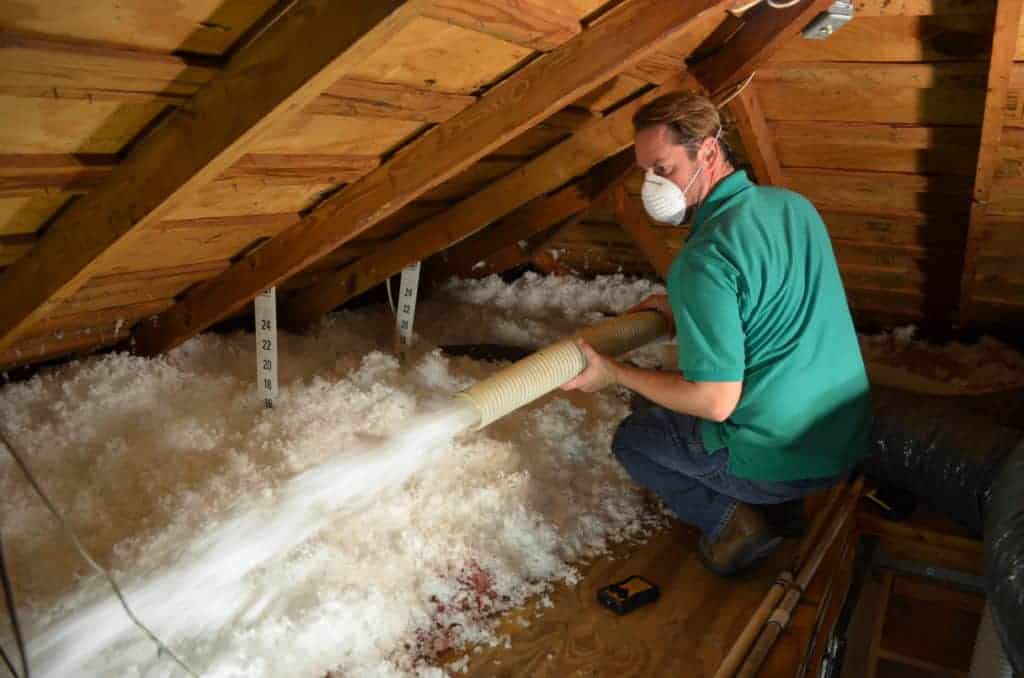
Insulation is one of the most important measures to ensure energy efficiency and to save money on your electricity bills. According to Austin Energy, “having your home properly insulated can save an estimated 25-30% of the cooling and heating season energy costs.”
Insulation is rated by its R Value, or its Resistivity to heat transfer. The R value varies by material type and is listed on the insulation’s packaging. The R value per inch also varies depending on the depth because it gets compressed as it gets deeper. R values are additive – if you add insulation of one type on top of an insulation of a dfferent type, the total resistivity is based on adding the two together.
Test It Yourself
It’s easy to determine whether you need to add insulation to your attic. Go up in the attic and look! Check for:
- Depth of insulation. This varies with different types of insulation and different climates, but in general a foot of insulation is a good amount. Take a ruler, and push it down into the insulation until it touches the floor of the attic. Try in multiple places. If you don’t have at least a foot, you need more. Most types of insulation used in Austin is recommended to be 14 inches.
- Gaps between insulation. If you have batts – the square pieces of insulation – it’s easy for gaps to open up between them. Make sure they are butted up against each other. If there are gaps it’s as if you have left a door or window open for the heat to transfer through.
- Uneven or missing insulation – There should be space to walk to any equipment housed in the attic, such as your HVAC and water heater. But if you have big areas where there is no or very low insulation, you need to fix that. If you want to store decorations and other stuff in the attic, put it onto a platform with insulation under it.
Types of Insulation
If any of the conditions above exist, add insulation. The most common types are:
- Blown insulation – Easy to fill into hard to reach areas, around wiring and able to provide consistent coverage.
- Fiberglass -Valued for its properties of nonconductivity and ability to capture air. It’s a petroleum product which isn’t as good environmentally, and the glass fibers are known to irritate skin
- Cellulose – Made from recycled materials, mostly wood based. Newer versions of cellulose are treated with fire retardant, insect repellent and mold restrucive properties. It is heavier than fiberglass. From an environmental point of view it’s preferred over petroleum-based fiberglass.
- Foam, sprayed – Foam can be sprayed along the roof line if you want to have the attic included in the conditioned (air heated and cooled) space. There are petroleum-based foams and bio-based. You must consider other elements of the home design to ensure the ventilation is adequate.
- Closed cell has a very good air barrier as well as a water vapor barrier that can be used outdoor or indoor. It’s suitable for outdoor applications, so can be used under pier and beam homes.
- Open cell is not good for outdoor use but is less expensive so good for indoors.
- Batts create the best sound barrier, so may be used in internal walls between rooms, but are NOT the best choice for external walls or attics. Studies at the University of Colorado have established that a blown-in insulation rated at R-19 provides equal performance to the same job done with R-30 batting.
Contractors and Rebates
Energy efficiency upgrades are best considered as a whole system. For instance, you should at least check your ductwork, and probably seal and/or replace before adding insulation to your attic. Make sure you work with someone who understands all aspects of energy efficiency.
Rebates are available from Austin Energy for residential, small business, multi-family and commercial properties. If you’re not an Austin Energy customer, check with your electric utility to learn about rebates in your area.
The contractors qualified to get the rebates from Austin Energy are listed on their website and are the most knowledgeable. The company that Robert and I founded and sold is one of those. Go Green!
